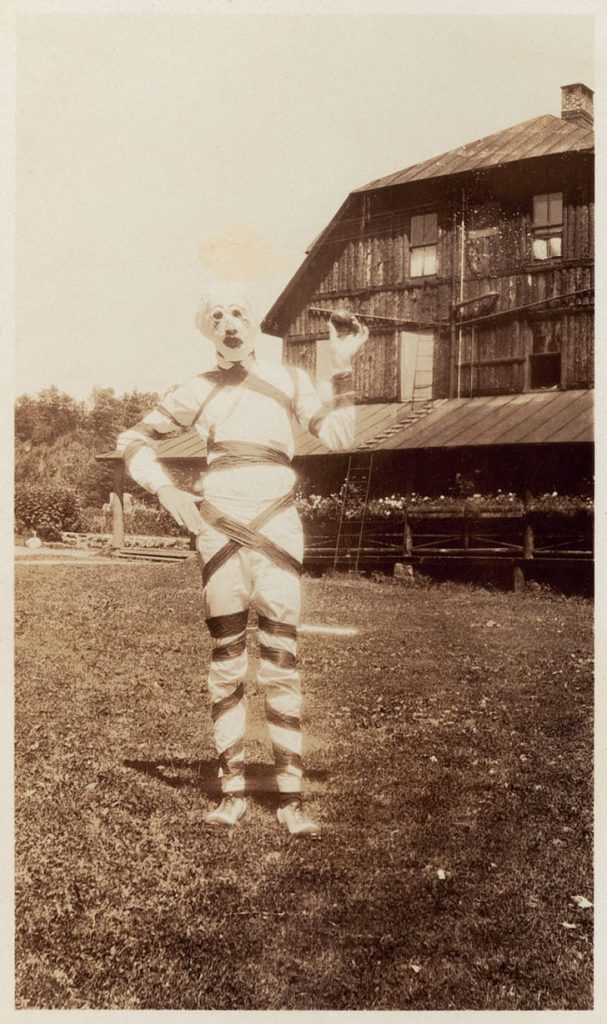Some Sunday Stuff: October 31st.

Happy Sunday, Happy Reformation Sunday for all my fellow Prots, and Happy All Hallow’s Eve, or Halloween.
And of course, Happy Birthday to my beautiful friend (now sister) Kiki. I thank God He saw fit to bring such an intelligent, well-read, funny, fashion-loving, inquisitive Native New Yawker into my life. xoxox
Now, let’s get to the stories, shall we? First up, this Mental Floss post by Michele Debczak, chock full of some downright creepy vintage costumes. What makes them so bizarre is the fact most aren’t supposed to be:



Yes, we hate to see it. But, if you want to see more, click here. From Hyperallergic, this story, by Lauren Moya Ford, about how witches have been viewed throughout history:
As a free, powerful, and unpredictable woman, the witch has long been a crucible for mainstream society’s darkest fears. One of the first recorded instances of the word ‘witch’ was in the Old Testament, where a merciless verse from Exodus commands, “Thou shalt not suffer a witch to live.” The story of the witch is inextricably linked with the brutality and persecution of the Reformation era. It’s estimated that 50,000 to 80,000 suspected witches were killed in Europe between 1500 and 1660. Some 70 to 80% of the victims were women, the majority being poor and elderly. Witches became a catchall scapegoat for all sorts of ills at the time, including disease, death, infertility, bad weather, and shipwrecks, and news of their highly publicized trials and supposed evil deeds spread like wildfire in books, pamphlets, and other propaganda thanks to the birth of the printing press.
It’s impossible to know how many of those accused were actually practitioners, but the mere threat of witchcraft — or of women acting independently outside of established norms — was enough to drive those in power to murderous hysteria. “The witch craze took different forms at different times and places, but never lost its essential character: that of a ruling class campaign of terror directed against the female peasant population,” historian Barbara Ehrenreich wrote in her 1972 book Witches, Midwives, and Nurses. “Witches represented a political, religious, and sexual threat to Protestant and Catholic churches alike, as well as to the State.”
With the rise of the Age of Enlightenment in the 1680s, witch hunts faded in Europe. But they continued in the New World, where they were used to villify Indigenous people, survivors of the translatlantic slave trade, and famously resulted in the execution of 19 villagers in Salem, Massachusetts in 1692. By the late 1800s, Western creatives began to reexamine the witch, recasting her as a nonconformist hero in their artworks. Witches later served as inspiration for the Surrealists and feminists in the 1960s, including the activist group W.I.T.C.H. (Women’s International Terrorist Conspiracy from Hell).

Read the piece in its entirety and check out more art here. Now, from costumes and witches, let’s switch gears to the topic of the COVID19 pandemic; or rather, the way in which the pandemic story has been told. From On The Media:

( Kurt Vonnegut / Youtube )
Coronavirus has now infected 242 million people and taken over 4.9 million lives worldwide. How do those figures make you feel? Shock? Sorrow? Anything? The pandemic is still very much ongoing and yet many of us are just too spent, too confused to react anymore. Maybe we’ve simply reached a limit.
This week, On the Media correspondent Micah Loewinger looks to Kurt Vonnegut’s theory of “the shapes of stories,” to understand what kinds of narratives sustain our attention. Micah speaks with Soren Wheeler, executive editor of Radiolab, and Rachael Piltch-Loeb, a preparedness fellow at the Harvard T.H. Chan School of Public Health, to make sense of how, and why, we lost the plot on Covid.
It’s a really good listen! It really made me think about what kind of stories I tend to watch in movies or on TV, and how I almost always narrativize my life, to give it order, meaning, and purpose. It also explains why as the pandemic has spread, bringing variants, waves, and crests, the unpredictability and the unevenness left me unnerved. I’ve felt like I’ve been living in a Jeremy Bearimy- and wondering if I’ve landed in The Bad Place.
Also, go watch The Good Place. Super good. Oh, wait, finish reading this post, and then go stream it. Next, this Atlantic story by Ethan Zuckerman, about, Mark Zuckerberg’s announcement aside, how the metaverse has been done before (and not just at DC), many times, and it sucked.
In a booth at Ted’s Fish Fry, in Troy, New York, my friend Daniel Beck and I sketched out our plans for the metaverse. It was November 1994, just as the graphical web was becoming a thing, and we thought that the 3-D web could be just a few tweaks down the road. In our version of the metaverse, a server would track the identity of objects and their location in virtual space, but you’d render the objects locally, loaded to your hard drive off of a CD-ROM. It made a certain sense: Most users were on sub-56k modems, and AOL was shipping out enough CD-ROMs to pave Los Angeles each week.
To be very clear, Daniel and I were in no way being original. We were hoping to re-create the vision that Neal Stephenson had outlined in his 1992 book, Snow Crash. We were both (barely) self-conscious enough to understand that Snow Crash took place in a dystopia, and that Stephenson was positing a beautiful virtual world because the outside world had become so shitty that no one wanted to live in it. But we were young and naive and believed that our metaverse would rock. (Stephenson, of course, wasn’t being entirely original either. His vision of the metaverse owed a debt to Vernor Vinge’s 1981 True Names and to a series of William Gibson novels from the ’80s. Both of those authors owed a debt to Morton Heilig’s 1962 Sensorama machine, and on and on we go, back in time to Plato’s shadows on a cave wall.)
Daniel and I got a chance to actually build our metaverse about six months later, after we both joined Tripod as graphic designers and “webkeepers.” This was well before Tripod became a competitor to GeoCities, offering free webpages to all. (It was also before I accidentally invented pop-up ads. Sorry again about that.) Instead, we were a lifestyle magazine for recent graduates, providing smart, edgy, but practical content—“tools for life”—while hawking mutual funds to 20-somethings. When that business model didn’t take off (can’t imagine why), the half-dozen folks in the “tech cave” revived the metaverse idea.
And so, we skinned a MOO—that is, an online environment meant for multiplayer games. Our friend Nathan Kurz hacked Pavel Curtis’s LambdaMOO code to turn an “object oriented multiplayer dungeon”—a multiplayer, text-based game—into a web-based, graphical experience. Each room in the MOO, which would normally have only a text-based description, was associated with six JPEG images representing directions you could go (up, down, north, south, east, west), each of which was an image map with objects you could click on and interact with. Melanie Stowell, who had spent much of her undergraduate education logged on to various MOOs and MUDs (multiuser dungeons, another kind of virtual game space), wrote the code to make this work, and Daniel and I made hundreds of images to illustrate the space, which were dutifully inserted into webpages via Nate’s code.
We sold our CEO on the idea by telling him that the MOO could be a simulation of life in the big city postcollege, bringing onto the site new users who wanted to experience New York City while still in Ann Arbor or State College. And remember, this was 1995: The photos we used to represent this metaverse of ours were taken on chemical film! Which we then developed at a photo-processing lab! And then scanned on a flatbed scanner!
The MOO was really cool, in theory. Most people weren’t building HTML-enabled multiplayer spaces in 1995. It got us our first round of venture-capital funding, demonstrating to our investors that we weren’t just kids translating mutual-fund propaganda into HTML. We were technology innovators. We were building things no one had ever seen before.
Zuckerman’s multiverse, unlike those blasted pop-ups, was not a success. Many others came along after, and flopped, as well. Second Life, though, really did seem to be on to something:
I was invited to the Metaverse Roadmap Summit in 2006 to see some of these “serious” Second Life spaces. The one that finally caused me to lose my shit was Camp Darfur, an exhibit designed to help metaverse explorers understand what Sudanese refugees were experiencing when they were displaced from their homes. Of course, this was Sudan as understood through the eyes of well-meaning Bay Area techies, which meant it featured a roaring campfire surrounded by wooden tree stumps where you could sit and contemplate the horrors of genocide. Given that women routinely walked miles from barren, tree-free desert camps to collect firewood, risking assault and rape in the process, it seemed like the sort of detail you’d want to get right in simulating the refugee experience. But simulations are never just about what they hope to simulate, and the simulations in Second Life were at least as much about demonstrating that Second Life was a serious place where people did serious things as they were about educating viewers about the horrors of ethnic cleansing. It was horrifying.
Yikes. Look, I said it seemed to be on to something, I didn’t say it was good. So Zuckerman was into this world back when Zuckerberg was in elementary school, so he seems to have the bona fides to write a critique in as august a publication as The Atlantic. And um:
Let’s be frank about this: Facebook’s metaverse sucks. From the first images in which legless torsos sit around a conference room, staring at a Zoom-like videoconferencing screen, to Zuckerberg’s tour of his virtual closet, filled with identical black outfits (see, he’s got a sense of humor!), Zuck’s metaverse looks pretty much like we imagined one would look like in 1994. Look, I’m playing cards with my friends and we’re in zero gravity! And one of my friends is a robot! You could do this in Second Life 10 years ago, and in somewhat angular vectors in VRML 20 years ago.
The graphics are a little better—though frankly, not that much better. The blocky avatars of Horizon Workrooms are so cartoonish because animating complex sets of polygons is pretty hard when they can all move in any given direction at any given time. Your video games look marvelous in part because we can predict that the terrain is (roughly) going to stay on the ground and that your character is going to take (roughly) predictable paths through the scenery. But in an open, user-created metaverse, a lot of inefficient polygons are flying around, which is why dance parties in Second Life suffered from terrible frame rates. (Not to mention the orgies.)
The metaverse Zuckerberg shows off in his video doesn’t have to solve those problems. He’s promising future technologies that are five to 10 years off. But it still looks like junk. The fire in his fireplace is a roughly rendered glow. His superhero secret lair looks out over a paradise island that’s almost entirely static. There’s the nominal motion of waves, but none of the foliage moves. It’s tropical wallpaper pasted to virtual windows. The sun is setting behind Zuckerberg’s left shoulder, but he’s being lit from the right front. Even with a bajillion dollars to invest in a video to relaunch and rename his company, Zuckerberg’s team is showing just how difficult it is to create a visually believable virtual world.
A bajillion dollars on regurgitated Second Life? This is the scariest item in today’s post. Anyway, read the whole thing here. And is it just me, or does the Meta logo look like a weird, blue pretzel?

That’s it for today, so enjoy Ella Fitzgerald with the naughty “Bewitched, Bothered, and Bewildered”. Have a great day.
